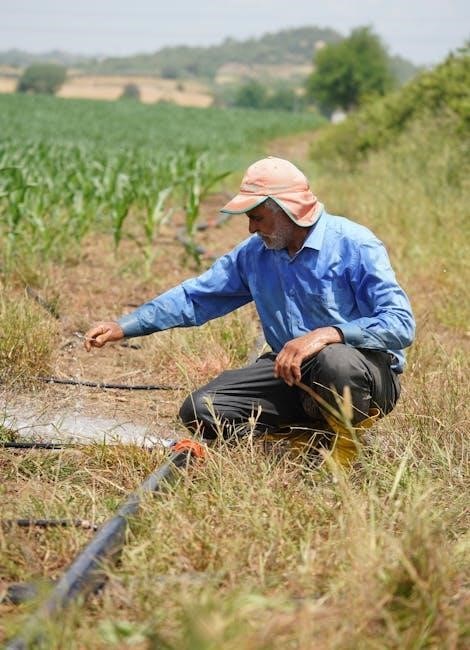Raindrip Irrigation Timer Manual: A Comprehensive Guide
Welcome to your comprehensive guide to Raindrip irrigation timers! This manual provides essential information for maximizing the efficiency of your watering system. From initial setup to troubleshooting, discover how Raindrip timers automate your drip system, saving you time and water, ensuring thriving plants.
Understanding Raindrip Irrigation Timers

Raindrip irrigation timers are designed to automate your watering schedule, providing a convenient and efficient way to keep your plants hydrated. These timers work by controlling the flow of water to your drip irrigation system, allowing you to set specific watering times and durations. This automation helps to reduce water waste and ensures that your plants receive consistent and optimal hydration, promoting healthier growth.

These timers are compatible with standard garden hose threads, making them easy to integrate into existing systems. They eliminate the need for manual watering, saving you time and effort. Additionally, Raindrip timers can be programmed to accommodate different watering needs based on plant type, weather conditions, and seasonal changes.
Smart timers come equipped with mobile app connectivity, offering remote control and monitoring of your watering schedule. This allows you to adjust settings from anywhere, ensuring your plants are cared for even when you’re away. Understanding the basic functionality and features of Raindrip timers is the first step towards optimizing your drip irrigation system and achieving a lush, thriving garden with minimal effort.
Key Features and Benefits of Raindrip Timers
Raindrip timers offer a range of features designed to simplify and enhance your watering experience. Key among these is automated scheduling, allowing you to set precise watering times and durations, ensuring consistent hydration for your plants. Many models include rain delay functions, which pause scheduled watering when rainfall is detected, preventing overwatering and conserving water resources.
The user-friendly interfaces, often featuring digital displays and intuitive controls, make programming straightforward and accessible for all users. Some smart timers offer mobile app integration, enabling remote control and monitoring from your smartphone or tablet. This provides the flexibility to adjust watering schedules based on real-time weather conditions or specific plant needs, even when you are away from home.
Raindrip timers are also designed with durability in mind, featuring weather-resistant construction to withstand outdoor elements. The benefits extend beyond convenience, promoting water conservation, healthier plant growth, and reduced manual labor. By automating your watering system, Raindrip timers contribute to a more sustainable and efficient gardening practice, saving you time, water, and money.
Raindrip Timer Models: R675CT, R682CP, R875CT
Raindrip offers a variety of timer models to suit different irrigation needs. The R675CT is an analog 3-dial water timer, ideal for simple, intuitive programming. It features a rain delay function and is well-suited for drip irrigation and garden sprinkler systems. Its straightforward design makes it easy to set watering frequency and duration without complex digital interfaces.
The R682CP timer provides a digital interface, offering more precise control over watering schedules. This model often includes multiple start times and watering durations, allowing for customized watering plans. The R682C-CT is another variation, offering similar digital functionalities and enhanced programming options, catering to users who require more flexibility in their watering regimes.
The R875CT is a hose-end smart water timer, designed for remote control via a mobile app. This smart timer enables users to monitor and adjust watering schedules from anywhere, providing real-time updates and alerts. It integrates with a gateway and power adapter to ensure reliable connectivity and operation, making it a sophisticated choice for modern irrigation management. These models represent Raindrip’s commitment to providing diverse and effective watering solutions.
Installation Guide: Setting Up Your Raindrip Timer

Proper installation is crucial for the optimal performance of your Raindrip timer. Begin by selecting a suitable location for your timer, ensuring it is protected from direct sunlight and extreme weather conditions. Connect the timer to your water source using a garden hose thread (GHT) connection, ensuring a snug fit to prevent leaks. Note that Raindrip timers are typically not compatible with British Standard Pipe Thread (BSP).
Next, attach your drip irrigation system to the timer’s outlet. Ensure all connections are secure to avoid water loss. If you’re using a smart timer like the R875CT, install the gateway and power adapter according to the manufacturer’s instructions. This will enable remote control and monitoring via the Raindrip app.

For timers requiring batteries, insert them before programming. The battery indicator light will show the power level, and it’s essential to replace batteries when the level is low to prevent valve shut-off. Finally, create a drip loop in the cable near where it enters your house to prevent water from running along the cable and into your home. Sealing the cable entry point with caulking further protects against water damage. With these steps, your Raindrip timer should be correctly installed and ready for programming.
Programming Your Raindrip Timer: A Step-by-Step Approach
Programming your Raindrip timer is straightforward, allowing you to customize watering schedules to suit your plants’ needs. Begin by familiarizing yourself with the timer’s interface, whether it’s an analog dial or a digital display. For analog timers like the R675CT, set the watering duration and frequency using the dials. Digital timers, such as the R682CP and R875CT, offer more precise control through their digital interfaces.
To program a digital timer, start by setting the current time and date. Then, define your watering start times and durations. You can typically set multiple start times per day, allowing for flexible watering schedules. Consider factors like plant type, soil conditions, and weather patterns when determining watering frequency and duration.
Smart timers like the R875CT can be programmed remotely via the Raindrip app. This allows you to adjust watering schedules from anywhere, monitor water usage, and receive alerts. Take advantage of features like rain delay, which pauses watering during rainy periods, conserving water. Remember to regularly review and adjust your settings as your plants grow and the seasons change, ensuring they receive the optimal amount of water. Always refer to the specific model’s instruction manual for detailed programming guidance.
Manual Watering Cycle: Adding Custom Watering Sessions
Sometimes, your plants might need extra attention beyond the programmed schedule. Raindrip timers offer a manual watering cycle, allowing you to add custom watering sessions as needed. This feature is especially useful during hot weather or when you notice plants are unusually dry.
To initiate a manual watering cycle, consult your timer’s manual for specific instructions, as the process varies slightly between models. Typically, there’s a button or setting labeled “Manual” or “Override.” Pressing this button will usually activate a pre-set manual watering duration, or allow you to set a specific time for the manual session.
For digital timers, you can often customize the duration of the manual watering cycle through the timer’s settings. This allows you to tailor the extra watering to the specific needs of your plants. Remember that manual watering overrides the programmed schedule temporarily, so be mindful of your regular settings. After the manual cycle completes, the timer will automatically revert to its programmed schedule.
The manual cycle feature gives you ultimate control over your watering, ensuring your garden stays healthy and hydrated even during unexpected conditions. Regularly checking your plants and using the manual cycle when necessary can prevent over or under-watering.
Troubleshooting Common Issues: Battery Replacement, Valve Problems
Even with proper care, Raindrip timers can sometimes encounter issues. Two common problems are battery failure and valve malfunctions. Addressing these promptly ensures your irrigation system continues running smoothly.
Battery Replacement: Raindrip timers typically use batteries to power their functions. When the battery level gets low, the timer may display a warning or stop functioning. Refer to your manual for the correct battery type. Replacing the batteries is usually straightforward: open the battery compartment, remove the old batteries, and insert the new ones, ensuring correct polarity. After replacement, test the timer to ensure it powers on correctly.
Valve Problems: The valve controls the water flow in your Raindrip system. If the valve isn’t opening or closing properly, your plants won’t receive water, or the system might leak. Check the valve for any debris or blockages. Clean the valve carefully, following the manufacturer’s instructions; Inspect the valve for physical damage. If the valve is severely damaged, it may need replacement.
By addressing battery and valve issues promptly, you can minimize disruptions to your watering schedule and keep your garden thriving. Always consult your Raindrip timer manual for specific troubleshooting steps related to your model.
Winterizing Your Raindrip Drip System
As temperatures drop, proper winterization is crucial for protecting your Raindrip drip system from damage caused by freezing. Water expands when it freezes, which can crack pipes, fittings, and timers. Taking preventative measures ensures your system remains functional for the next growing season.
Step 1: Shut Off Water Supply: Begin by turning off the main water supply to your drip irrigation system. This prevents any further water from entering the system during the winter months.
Step 2: Drain the System: Open all the end caps and drain valves to allow water to completely drain from the pipes and tubing. Gravity will help remove most of the water. For systems with elevation changes, open valves at the lowest points to ensure thorough drainage.
Step 3: Disconnect and Store Timer: Disconnect the Raindrip timer from the faucet or hose. Remove the batteries to prevent corrosion. Store the timer indoors in a dry, protected location where it won’t be exposed to freezing temperatures.
Step 4: Protect Backflow Preventer: Insulate the backflow preventer with a thermal blanket or remove it and store it indoors to prevent freezing.
By following these steps, you’ll safeguard your Raindrip drip system from winter damage, ensuring its longevity and efficient operation for seasons to come.
Water Saving Tips with Raindrip Irrigation
Raindrip irrigation systems are designed for efficient water use, but you can maximize savings with smart practices. Understanding your plants’ needs and optimizing your system are key to reducing water waste and promoting healthy growth.
Adjust Watering Schedules: Monitor weather conditions and adjust your Raindrip timer accordingly. Reduce watering during rainy periods or cooler weather. Use the timer’s rain delay feature if available.
Group Plants by Water Needs: Plant species with similar water requirements together. This allows you to tailor watering zones to match specific needs, preventing overwatering or underwatering.
Use Mulch: Apply a layer of mulch around plants to reduce evaporation and retain soil moisture. Organic mulches like wood chips also improve soil health.
Check for Leaks: Regularly inspect your drip system for leaks or damaged components. Repair or replace any faulty parts promptly to prevent water loss.
Optimize Emitter Placement: Ensure emitters are placed directly near the plants’ root zones for efficient delivery. Adjust emitter flow rates based on plant size and water needs.
By implementing these water-saving tips, you can significantly reduce your water consumption while maintaining a thriving garden with your Raindrip irrigation system.
Raindrip App and Smart Timer Functionality
Raindrip’s smart timers elevate your irrigation control to a new level with the Raindrip mobile app. This integration provides remote access and advanced features, optimizing water usage and simplifying garden management.
Remote Control: The Raindrip app allows you to control your watering schedule from anywhere. Adjust run times, start or stop watering cycles, and monitor system status remotely.
Smart Scheduling: Utilize the app’s intelligent scheduling features to customize watering based on weather forecasts and plant needs. Set up automated schedules that adapt to changing conditions.
Real-time Monitoring: Track water usage, battery levels, and system performance through the app. Receive alerts for low battery or potential issues, ensuring timely maintenance.
Easy Setup: Connect your Raindrip smart timer to your home Wi-Fi network through the app. The intuitive interface guides you through the setup process, making it simple to get started.
Customized Zones: Manage multiple watering zones with individual settings. Tailor watering schedules for different areas of your garden based on plant types and environmental factors.
With the Raindrip app and smart timer functionality, you gain unparalleled control over your irrigation system, promoting water conservation and healthy plant growth.